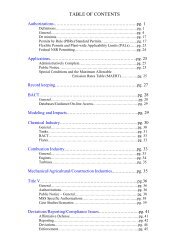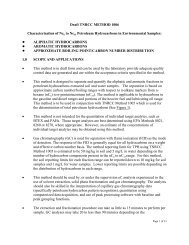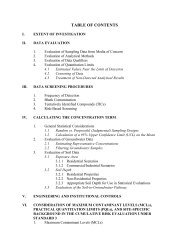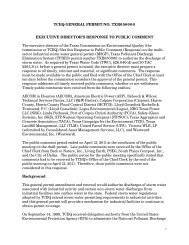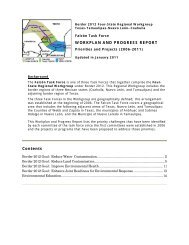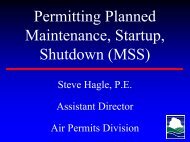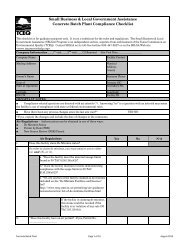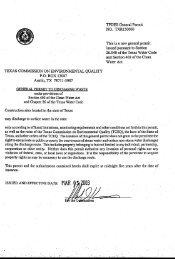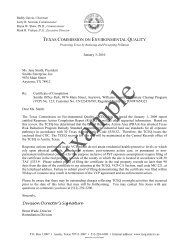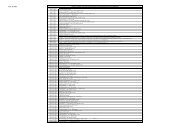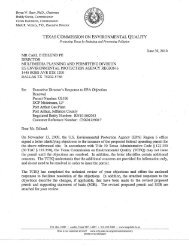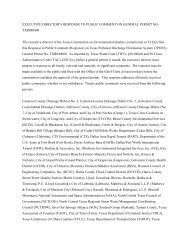Hydropneumatic Pressure Tank - TCEQ e-Services
Hydropneumatic Pressure Tank - TCEQ e-Services
Hydropneumatic Pressure Tank - TCEQ e-Services
Create successful ePaper yourself
Turn your PDF publications into a flip-book with our unique Google optimized e-Paper software.
TEXAS COMMISSION ON ENVIRONMENTAL QUALITY<br />
HYDROPNEUMATIC PRESSURE TANK<br />
GENERAL CONSTRUCTION NOTES<br />
1. These water well facilities must be constructed in accordance with the Texas<br />
Commission on Environmental Quality (<strong>TCEQ</strong>) Rules and Regulations for Public<br />
Water Systems 30 Texas Administrative Code (TAC) Chapter 290 Subchapter D.<br />
2. All hydro-pneumatic tanks must be located wholly above grade and must be of<br />
steel construction with welded seams except as providing in note No. 10 of these<br />
construction notes.<br />
3. Metal thickness for pressure tanks shall be sufficient to withstand the highest<br />
expected working pressures with a four to one factor of safety. <strong>Tank</strong>s for 1000<br />
gallon capacity or larger must meet the standards of the American Society of<br />
Mechanical Engineers (ASME) Section VIII, Division 1 Codes and Construction<br />
Regulations and must have an access port of periodic inspections. An ASME<br />
name plate must be permanently attached to those tanks. <strong>Tank</strong>s installed before<br />
July 1, 1988, are exempt from the ASME coding requirement, but all new<br />
installations must meet this regulation. Exempt tanks can be relocated within a<br />
system, but cannot be relocated to another system.<br />
4. All pressure tanks shall be provided with a pressure release device and an easily<br />
readable pressure gauge.<br />
5. Facilities shall be provided for maintaining the air-water-volume at the design<br />
water level and working pressure. Air injection lines must be equipped with<br />
filters or other devices to prevent compressor lubricant and other contaminants<br />
from entering the pressure tank. A device to readily determine air-water-volume<br />
must be provided for all tanks greater than 1000 gallon capacity. Galvanized<br />
tanks which are not provided with the necessary fittings and were installed before<br />
July 1, 1988, shall be exempt from this requirement.<br />
6. <strong>Hydropneumatic</strong> pressure tanks shall be painted, disinfected and maintained in<br />
strict accordance with current AWWA standards. Protective paint or coating shall<br />
be applied to the inside portion of any pressure tank. However, no temporary<br />
coating, wax, grease coating or coating materials containing lead will be allowed.<br />
No other coating will be allowed which are not approved for use (as a contact<br />
surface with potable water by the United Sates environmental Protection Agency<br />
(EPA), National Sanitation Foundation (NSF), The United States Food and Drug<br />
Administration (FDA). All newly installed coatings must conform to ANSI/ NSF<br />
Standard 61 and must be certified by an organization accredited by ANSI.<br />
7. No pressure tank that has been used to store any material other than potable<br />
water may be used in a public water system. A letter from the previous owner or<br />
owners must be provided.<br />
8. <strong>Pressure</strong> tank installations should be equipped with slow closing valves and time<br />
delay pump controls to eliminate water hammer to reduce the chance of tank<br />
failure.<br />
9. Associated appurtenances including valves pipes and fittings connected to<br />
pressure tanks shall be thoroughly tight against leakage.<br />
June 13, 2007 Page 1of 2
10. Where seamless fiberglass tanks are utilized, they shall not exceed 300 gallons in<br />
capacity.<br />
11. No more than three pressure tanks shall be installed at any one site without the<br />
prior approval of the executive director.<br />
12. All potable water storage tanks and pressure maintenance facilities must be<br />
enclosed by an intruder resistant fence with lock-able gates. Pedestal type<br />
elevated storage tanks with lock-able doors and without external ladders are<br />
exempt from this requirement. The gates and odors must be kept locked<br />
whenever the facility is unattended.<br />
June 13, 2007 Page 2of 2




